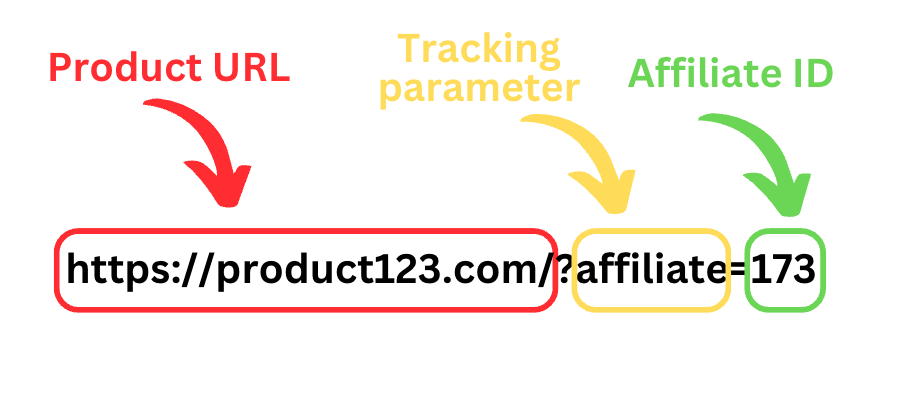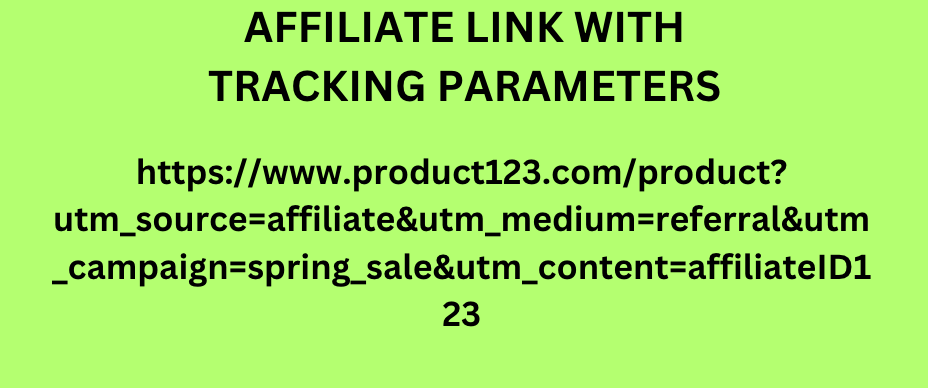An affiliate link is a URL that contains an ID associated with a partner of a product.
If a customer makes a purchase through that link, the partner earns a commission.
🌟💡 Nick promotes Jon’s T-shirts using affiliate links.
Jon can see whenever someone makes a purchase through Nick’s affiliate link.
This way, Jon can easily pay Nick a small commission as compensation.
Affiliate links are what make affiliate marketing work.
In this post, I will show you a bunch of different types of affiliate links. I’ll also teach you how to identify affiliate links in different contexts.
What Does an Affiliate Link Look Like?
A basic affiliate link looks something like this.

There’s the URL to the product’s or company’s landing page.
Then that URL is followed by the tracking parameter, such as “affiliate”.
And that’s followed by a unique identifier that belongs to a particular affiliate. If there are 100 affiliates for a particular product, there are also 100 unique links with different IDs.
The power of a link like this is that the advertiser can use the URL ID to identify which partner sent traffic their way.
This way, they can easily pay commissions to the partners if someone makes a purchase (or completes a desired action).
But not all affiliate links look like this.
As a matter of fact, if you now search for some products just based on this one example, you probably won’t be able to tell if it’s an affiliate link or not.
You need to see more examples and common characteristics of affiliate links to learn what they actually look like.
Example 1
Many affiliate links might look like this:

This is a redirected affiliate link.
Once someone clicks this link, it redirects to product123’s page instead of myblog.com.

So basically, a redirect link just makes the affiliate link look nicer and lowers the barrier of clicking through.
But in reality, the redirected link is just the same dirty affiliate link in disguise.
Example 2
Sometimes affiliate links can also look like this:

This can be confusing. There’s no name of the product, no affiliate ID, nothing.
It’s just a short link with numbers, characters, and backslashes.
The idea of this affiliate link is to make affiliate links shorter.
So it’s actually exactly the same idea as in the previous example. Just to hide the fact that the original link looks dirty and verbose and takes a lot of space.
But why, you may ask?
A common way to use affiliate links in social media is by adding those to profile bios.
If the character limit of a bio is e.g. 80 characters and your link is 120 characters, how on earth could you fit that in?
That’s one great reason for shortening the links! 🙂
Example 3
The third example is an affiliate link with a lot of tracking parameters (utm_something).

Those tracking parameters make affiliate links really long. But they serve a critical purpose too!
When someone clicks a link with tracking codes, the website owner gets valuable data about the action.
For example, the tracking parameters could tell the website owner the following about the visitor:
- They came from an affiliate called “Nick” with ID 123
- They promoted a product belonging to the spring sale campaign.
With tons of products, affiliates, and campaigns, it would be impossible to track the performance without knowing where the traffic comes from.
This is what those tracking parameters do. And this is why affiliate links tend to be long.
In smaller companies’ affiliate programs, you commonly only see the affiliate ID in the URL.
But with bigger companies with tons of products and different campaigns, the affiliate links involve tons of tracking codes to help sort out all the data and gather information about different promotions.
Example 4
Another common affiliate link type is one that includes a coupon or promo code in the URL.

This works basically exactly like an affiliate link with a unique ID.
Let’s say Alice is a partner of Product123.
Product123 is on a special sale of 20% for people using coupon code “Alice20”.
If someone uses the coupon code (in other words, clicks a link with ?coupon=alice20 at the end of the URL), the company behind Product123 knows:
- To give 20% off for the visitor
- Pay a commission for Alice for promoting their product
Wrap Up
An affiliate link is a unique URL that contains the affiliate’s ID.
Affiliate links are an integral part of affiliate marketing. They help track the traffic sent to the advertiser’s website.
If a customer makes a purchase or completes a desired action through that link, the affiliate earns a commission.
Thanks for reading. Happy writing!
